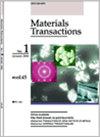Suggestion of a New Repair Technique for Steel Structures by Low-Pressure Cold Spray and Laser Cleaning
IF 1.9
4区 材料科学
Q4 MATERIALS SCIENCE, MULTIDISCIPLINARY
引用次数: 1
Abstract
The effectiveness of a corrosion repair technique consisting of laser cleaning and cold spraying was investigated. The effect of laser pulse frequency on the removal of surface corrosion on steel specimens was analyzed. Subsequently, a zinc coating was cold-sprayed on specimens cleaned of surface corrosion using conventional disc grinder and laser methods. Furthermore, salt spray tests were conducted to compare the corrosion protection performance of the zinc coating on these specimens. The results showed that laser cleaning can effectively remove surface corrosion and that a laser pulse frequency of 15 kHz is more effective than that of 40 kHz for removing the surface oxide layer. A comparison of cold-sprayed zinc coatings on laser-cleaned and non-treated specimens indicated that surface oxidation during laser treatment may negatively affect zinc deposition efficiency. The zinc coating on the laser-cleaned specimen was more than twice as thick as that on the conventionally cleaned specimen, and the coating–specimen interface maintained good adhesion after a 168 h salt spray test. Although no corrosion was observed in both steel specimens after the salt spray test, cracking of the remaining corroded areas on the substrate and delamination of the coating occurred in the conventionally cleaned specimen.低压冷喷涂和激光清洗对钢结构修复新技术的建议
研究了激光清洗与冷喷涂相结合的腐蚀修复技术的有效性。分析了激光脉冲频率对钢试样表面腐蚀去除的影响。随后,用传统的圆盘磨床和激光方法对表面腐蚀的样品进行冷喷涂锌涂层。并进行了盐雾试验,比较了镀锌层对两种试样的防腐性能。结果表明,激光清洗能有效去除表面腐蚀,激光脉冲频率为15 kHz比40 kHz对去除表面氧化层更有效。对激光清洗和未处理样品的冷喷涂锌涂层进行了比较,结果表明,激光处理过程中表面氧化会对锌沉积效率产生不利影响。经168 h盐雾试验,激光清洗试样表面的锌涂层厚度是常规清洗试样的2倍以上,镀层与试样界面保持良好的附着力。尽管在盐雾试验后,两种钢试样均未观察到腐蚀,但在常规清洁的试样中,基材上剩余腐蚀区域出现开裂和涂层分层。
本文章由计算机程序翻译,如有差异,请以英文原文为准。
求助全文
约1分钟内获得全文
求助全文
来源期刊

Materials Transactions
工程技术-材料科学:综合
CiteScore
2.00
自引率
25.00%
发文量
205
审稿时长
2.7 months
期刊介绍:
Information not localized
 求助内容:
求助内容: 应助结果提醒方式:
应助结果提醒方式:


